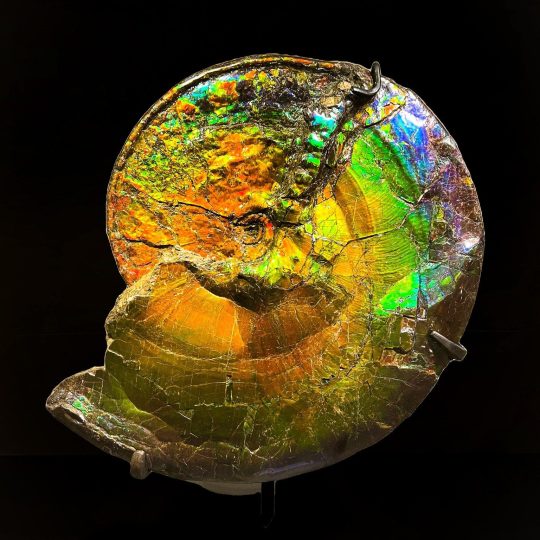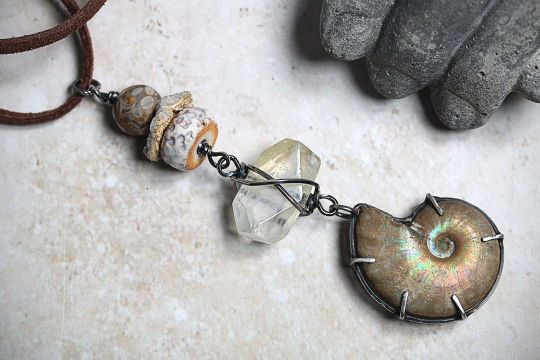#iridescent ammonite
Photo




Iridescent Ammonite
Canada
From the Upper Cretaceous, Bearpaw formation (75-72 million years ago), the 161⁄4-inch specimen of Placenticeras meeki displaying a dazzling iridescence of reds and oranges, greens and rich blues.
#iridescent ammonite#fossilised ammonite shells#fossil#gemstone#geology#geologist#ancient artifacts#history#history news#ancient history#pretty#beauty#beautiful
78 notes
·
View notes
Text

A stunning iridescent ammonite fossil. [source]
#iridescent#angelcore#ammonite#fossil#ammonite fossil#geology#aesthetic#beach#ocean aesthetic#oceanic#nature#naturecore#earth#earthy#earthcore#nature aesthetic#earthy aesthetic#science
15K notes
·
View notes
Text

Behold the dazzling colors of an iridescent ammonite (Placenticeras intercalare)! A relative of today’s squids, this ammonite lived some 80 million years ago near what is now Alberta, Canada. This fossil’s spectacular coloration is the result of millions of years of high temperatures and pressures. As these forces acted on nacre in this ammonite’s shell, it was transformed into a gemstone known as an ammolite. Along with amber and pearl, ammolite is one of only a handful of gems made by living organisms. You can spot this rare specimen in the Louis V. Gerstner, Jr. Collections Core in the Museum’s Richard Gilder Center for Science, Education, and Innovation!
Photo: © AMNH
#amnh#museum#science#nature#fossil#natural history#animals#paleontology#ammonite#ammolite#did you know#fact of the day#rainbow#cool animals#alberta#pride#iridescent#cephalopods#squid#ancient animals
1K notes
·
View notes
Text
Ammolite is a truly unique gemstone found almost exclusively in southern Alberta, Canada. It is formed from the fossilized (opalized) shells of ammonites.
📽️: Geologicgallery
270 notes
·
View notes
Text

Caramel or Precious rock?
I hope both
#precious#geology#rocks and minerals#minerals#crystals#cool rocks#aquamarine#morganite#mineral#exhibit#exhibits#minas gerais#brazil#munich#nature#iridescent#angelcore#ammonite#fossil#ammonite fossil#aesthetic#beach#ocean aesthetic#oceanic#naturecore#earth#earthy#earthcore#nature aesthetic#earthy aesthetic
22 notes
·
View notes
Text




jeremysinkus - credit me (link or tag) if using!
#stim#stimblr#visual stim#stimmy#sensory#stimming#gifs#gif set#stim gifs#ammonite#ammonite stim#fossil#fossil stim#glass#glass stim#iridescent#iridescent stim#rainbow#rainbow stim
10 notes
·
View notes
Photo

From Madagascar, this rainbow ammonite has a beautiful iridescence and amazing texture. Around it, I have created a sterling silver prong frame to keep it secure in this rustic pendant with other handmade and nature-made treasures from my travels. It is an ode to all that is earthy and raw. Above the ammonite is a salvaged citrine quartz stone that I have wrapped in sterling silver and it connects to one of my own ceramic beads that I handmade at a small pottery in Nottinghamshire. It has an organic shape inspired by pebbles you'd find on a beach. In between is a chalcedony geode that I have cut and drilled myself and above that sits a matt finish Jasper fossil bead with crinoid inclusions and beautiful textures. Available in my Etsy shop. . . . #ammonite #rainbowammonite #iridescent #rainbownecklace #fossilnecklace #citrinequartz #ceramicbead #handmadetreasure #chalcedonygeode #jasperbead #crinoid #primitivejewellery #necklaceforhim #fossilhunter #rainbowiridescent #pearlessence #rusticstyle https://www.instagram.com/p/Cnm8eDet8rr/?igshid=NGJjMDIxMWI=
#ammonite#rainbowammonite#iridescent#rainbownecklace#fossilnecklace#citrinequartz#ceramicbead#handmadetreasure#chalcedonygeode#jasperbead#crinoid#primitivejewellery#necklaceforhim#fossilhunter#rainbowiridescent#pearlessence#rusticstyle
0 notes
Note
Here's a rainbow iridescent ammonite shell

Sadly my camera cannot capture how beautifully the light bounces off its many hues
pretty!!
27 notes
·
View notes
Photo

An iridescent ammonite fossil. [source]
10 notes
·
View notes
Text



Large Iridescent Ammonite
Placenticeras costatum
Late Cretaceous (approx. 71 million years ago)
Bearpaw Formation, Alberta, Canada
#Large Iridescent Ammonite#Placenticeras costatum#Late Cretaceous#Bearpaw Formation#alberta canada#paleontologist#ancient artifacts#archeology#archeolgst#history#history news#fossils#art history
70 notes
·
View notes
Text
ok so my lovely mutual @icarrymany dared me to post proof of my rock/min collection so this is his fault >:)
im not gonna go into depth on all of the samples bc 1. i dont remember the details on all of them lol and 2. it would take. forever
so instead ill talk a little abt one or two of them per section :3
first up: tumbled minerals!
i have a bunch more of these but after becoming a geology student they kind of piss me off bc raw minerals often look way cooler and tumbling removes the crystal habit (and also makes them harder for me to identify hgjhfd)



first image, from left clockwise: (possibly) blue lace agate, chrysocolla. labradorite, snowflake obsidian, moss agate, brown agate, and two samples of tigers eye
2nd image: up close picture of one of the tigers eye crystals, showing its lighter banding
3rd image: up close picture of the labradorite from a different angle, showing its pale green luster
my absolute favorite mineral ever is labradorite also!! i think its luster is gorgeous and ive heard it represents transformation and change, and i first got this sample back when i had just come out as trans :)
i dont really have a lot to say abt these unfortunately lol
anyway. next is fossils!!




1st image, clockwise from bottom left: trilobite cast fossil, tumbled stromatolite, dinosaur bone (? got this one at a mineral stall and the dude said it was a dino bone, didnt think to ask details lol), plant fossil, coral fossil, assorted fossil molds (mold as in taking the shape of something, not spores) in wackestone, mosasaurus tooth, crocodile (?) tooth, 2 ammonites, a turtle scute, a crinoid stem, and a (broken) orthoceras
2nd image: up close pic of the assorted fossil molds, which include horn corals (circular with ridges toward center, hole in middle), crinoid stems (cylindrical with ridges perpendicular to long sides), and shells
3rd image: up close pic of larger ammonite, with iridescent luster due to aragonite (a polymorph of calcite) replacing the calcite of the shell
4th image: up close pic of dubious tooth. i found this on a field trip about a year ago while looking for shark teeth. this is not a shark tooth. idk what it is. i think it might be from a crocodile but i havent been able to fully identify it lol
now.... raw minerals!!!!!






1st image, clockwise from left: moss agate, talc, serpentinite (this one is a metamorphic rock but i accidentally put it with the minerals and dont want to retake the pics. other geologists you may come kill me), two calcite samples, and a tiny topaz @ramones2 gave me
2nd pic: close up on the topaz crystal, which is light orange (if u leave these in the sun they get bleached and lose their color </3)
3rd pic: close up on one of the calcites. its crystals are a bit more squared and close-knit than the next calcite, and appear more white in color. there are also some small purple fluorite crystals mixed in. i traded with a classmate for this one lol
4th pic: close up on the other calcite. this ones crystals are more rounded and transparent.
5th pic: close up on the serpentinite. serpentinite is metamorphosed from peridotite, which makes up the earth's mantle (if youve ever heard that the mantle is actually green, that is true!! the green comes from olivine mostly, but also some pyroxenes). when peridotite is lifted up to the surface and comes into contact with water, olivine gets very unhappy and serpentinizes, or hydrothermally metamorphoses (water + some heat + olivine = cool as fuck snakeskin rock)
6th pic: another close up on the serpentinite, this time wet. you can see the serpent-like pattern a bit better.
finally: rocks :3




1st image, clockwise from bottom left: amphibolite, sedimentary rock with calcite vein (i dont remember what this one is lmao), malachite-bornite ore, iron-stained sandstone(?) with chalcedony/agate, phyllite, sandstone trace fossil of a burrow, and meteoric rock possibly with iron
2nd pic: close up on the ore, showing the malachite vein. it's almost powdery, with a gradient of light blue on the edges to teal in the center
3rd pic: another close up on the ore, showing the bornite vein. it's iridescent like an oil slick, with the main color being purple. this one is often called peacock ore for its colors :)
4th pic: . im gonna be honest i have no fucking clue bro. i think the mineral in it is agate/chalcedony (the lighter gray/white areas) and the red parts are an iron-stained sedimentary rock, but i forget if its siltstone or sandstone or smth else. idk. it looks cool.
bonus: extra pic of my rocks for further proof of collection

hope u enjoyed o7
#i finally had an excuse to ramble abt my rock collection THANK U BRIAN <333#i really should have written down somewhere what each sample was but. listen#i had. 5 different field trips for my geology classes this past semester#and half the time i didnt even ask what a rock was i just fucking took it HJFGBHD#if i really studied them i could probably figure out more reliably what some of them are#but i dont want to <3#at least not rn lol#ANYWAYS yeah#rawks 👍
11 notes
·
View notes
Text

The Rare Gemstone Ammolite.
This dazzling iridescent fossil of an 80 million year old ammonite measuring two feet in diameter was discovered near Alberta, Canada and is a particularly rare example of an ancient sea creature that went extinct at the same time as most dinosaurs. The spectacular coloration is the result of millions of years of high temperatures and pressures acting on the animal’s shell to create a gemstone known as ammolite.
25 notes
·
View notes
Text

Rare Ammonite Fossil. transformed into a beautiful iridescent gemstone called ammolite. Found in Alberta, Canada.
Photo: DavidMorGems
68 notes
·
View notes



